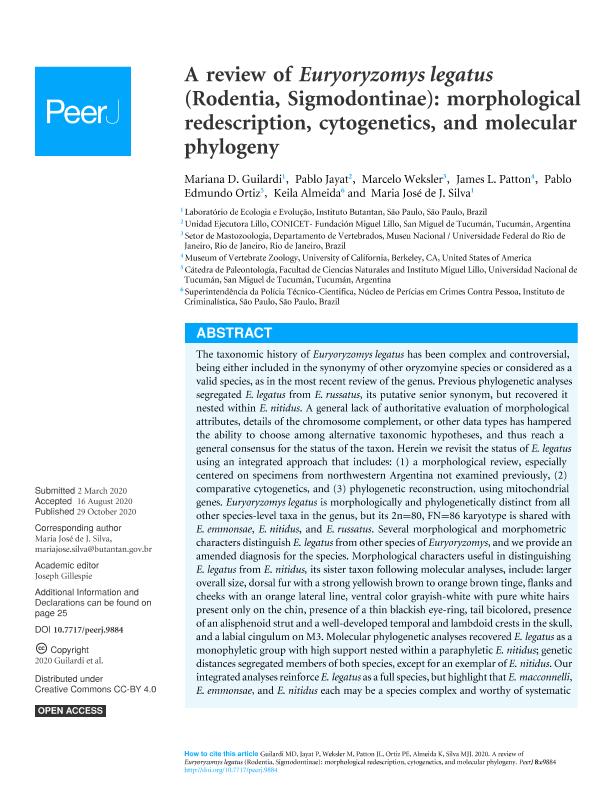Artículo
A review of euryoryzomys legatus (Rodentia, sigmodontinae): Morphological redescription, cytogenetics, and molecular phylogeny
Guilardi, Mariana D.; Jayat, Jorge Pablo ; Weksler, Marcelo; Patton, James L.; Ortiz, Pablo Edmundo
; Weksler, Marcelo; Patton, James L.; Ortiz, Pablo Edmundo ; Almeida, Keila; De Silva, Maria José
; Almeida, Keila; De Silva, Maria José
 ; Weksler, Marcelo; Patton, James L.; Ortiz, Pablo Edmundo
; Weksler, Marcelo; Patton, James L.; Ortiz, Pablo Edmundo ; Almeida, Keila; De Silva, Maria José
; Almeida, Keila; De Silva, Maria José
Fecha de publicación:
10/2020
Editorial:
PeerJ Inc.
Revista:
PeerJ
ISSN:
2167-8359
Idioma:
Inglés
Tipo de recurso:
Artículo publicado
Clasificación temática:
Resumen
The taxonomic history of Euryoryzomys legatus has been complex and controversial, being either included in the synonymy of other oryzomyine species or considered as a valid species, as in the most recent review of the genus. Previous phylogenetic analyses segregated E. legatus from E. russatus, its putative senior synonym, but recovered it nested within E. nitidus. A general lack of authoritative evaluation of morphological attributes, details of the chromosome complement, or other data types has hampered the ability to choose among alternative taxonomic hypotheses, and thus reach a general consensus for the status of the taxon. Herein we revisit the status of E. legatus using an integrated approach that includes: (1) a morphological review, especially centered on specimens from northwestern Argentina not examined previously, (2) comparative cytogenetics, and (3) phylogenetic reconstruction, using mitochondrial genes. Euryoryzomys legatus is morphologically and phylogenetically distinct from all other species-level taxa in the genus, but its 2n=80, FN=86 karyotype is shared with E. emmonsae, E. nitidus, and E. russatus. Several morphological and morphometric characters distinguish E. legatus from other species of Euryoryzomys, and we provide an amended diagnosis for the species. Morphological characters useful in distinguishing E. legatus from E. nitidus, its sister taxon following molecular analyses, include: larger overall size, dorsal fur with a strong yellowish brown to orange brown tinge, flanks and cheeks with an orange lateral line, ventral color grayish-white with pure white hairs present only on the chin, presence of a thin blackish eye-ring, tail bicolored, presence of an alisphenoid strut and a well-developed temporal and lambdoid crests in the skull, and a labial cingulum on M3. Molecular phylogenetic analyses recovered E. legatus as a monophyletic group with high support nested within a paraphyletic E. nitidus; genetic distances segregated members of both species, except for an exemplar of E. nitidus. Our integrated analyses reinforce E. legatus as a full species, but highlight that E. macconnelli, E. emmonsae, and E. nitidus each may be a species complex and worthy of systematic attention. Finally, we also evaluated the chromosome evolution of the genus within a phylogenetic context.
Archivos asociados
Licencia
Identificadores
Colecciones
Articulos(INSUGEO)
Articulos de INST.SUP.DE CORRELACION GEOLOGICA
Articulos de INST.SUP.DE CORRELACION GEOLOGICA
Articulos(UEL)
Articulos de UNIDAD EJECUTORA LILLO
Articulos de UNIDAD EJECUTORA LILLO
Citación
Guilardi, Mariana D.; Jayat, Jorge Pablo; Weksler, Marcelo; Patton, James L.; Ortiz, Pablo Edmundo; et al.; A review of euryoryzomys legatus (Rodentia, sigmodontinae): Morphological redescription, cytogenetics, and molecular phylogeny; PeerJ Inc.; PeerJ; 8; 10-2020
Compartir
Altmétricas



